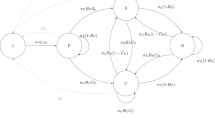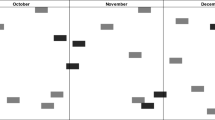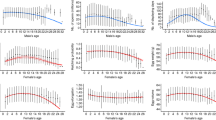Abstract
WILDEBEEST (Connochaetes taurinus Thomas) herds numbering nearly 1 million (refs 1, 2) on the Serengeti Plains, Tanzania, produce about 80% of their young during a 3-week period in January or February3. This is short compared with the 2-month birth period of the wildebeest in South Africa4, or to the 3–4-month birth period of buffalo and other grazers in the Serengeti5. A suggested advantage for the closely synchronised wildebeest birth period is that it reduces the probability of hyaena (Crocuta crocuta Erxleben) predation on the young3,6–8. I report here evidence which suggests that the lunar cycle is the external timer for the synchronisation.
This is a preview of subscription content, access via your institution
Access options
Subscribe to this journal
Receive 51 print issues and online access
$199.00 per year
only $3.90 per issue
Buy this article
- Purchase on Springer Link
- Instant access to full article PDF
Prices may be subject to local taxes which are calculated during checkout
Similar content being viewed by others

References
Sinclair, A. R. E., E. Afr. Wildl. J. 11, 93–107 (1973).
Norton-Griffiths, M., E. Afr. Wildl. J. 11, 135–149 (1973).
Estes, R. D., E. Afr. Wildl. J. 14, 135–152 (1976).
Fairall, N., Zool. Afr. 3, 189–210 (1968).
Sinclair, A. R. E., E. Afr. Wildl. J. 12, 169–183 (1974).
Estes, R. D., Nature 212, 999–1000 (1966).
Kruuk, H., The Spotted Hyena (Chicago University Press, Chicago, 1972).
Wilson, E. O., Sociobiology (Belknap Press, Cambridge, Massachusetts, 1975).
Hugget, A. St. G., & Widdas, W. F., J. Physiol. Lond. 114, 306–317 (1951).
Talbot, L. M. & Talbot, M. H., Wildl. Monogr., Chestertown No. 12 (1963).
Watson, R. M., J. Reprod. Fert., Suppl. 6, 287–310 (1969).
Turner, M. I. M., Chief Park Wardens Report 1965–1966, Serengeti National Park (mimeographed, 1966).
Siegel, S., Nonparametric Statistics (McGraw-Hill, New York, 1956).
Sinclair, A. R. E., The African Buffalo (Chicago University Press, Chicago, 1977).
Menaker, W. & Menaker, A., Am. J. Obst. Gynec. 77, 905–914 (1959).
Sadleir, R. M. F. S., The Ecology of Reproduction in Wild and Domestic Animals (Methuen, London, 1969).
Author information
Authors and Affiliations
Rights and permissions
About this article
Cite this article
SINCLAIR, A. Lunar cycle and timing of mating season in Serengeti wildebeest. Nature 267, 832–833 (1977). https://doi.org/10.1038/267832a0
Received:
Accepted:
Published:
Issue Date:
DOI: https://doi.org/10.1038/267832a0
This article is cited by
-
Male rutting calls synchronize reproduction in Serengeti wildebeest
Scientific Reports (2018)
Comments
By submitting a comment you agree to abide by our Terms and Community Guidelines. If you find something abusive or that does not comply with our terms or guidelines please flag it as inappropriate.


